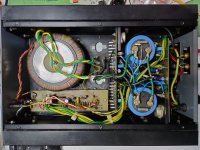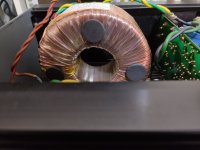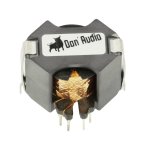Was 50Hz noise frequency the dominant contributor to 'N' for the -80dBV level, and is it still the dominant contributor to the -90dB 'N' now?
No, the grunge mainly was. I had the 50Hz controlled enough by optimum Tx orientation although the grunge wasn't going away much. But the flux band cleared that a lot. Especially for the closest amp channel board.
So that 'grunge' would have been 50Hz sidebands to any test signal passing through the amp (ie. discernible 50Hz side-lobes on a fundamental and its HD frequencies)?
Unfortunately I didn't keep the older measurement on file. I remember the N+D number and higher visual clutter before and after the test frequency. There's 30dB voltage gain and an output relay nearby as well. Tx hum field could have been coupling in many ways.
Attachments
There are transformers built like that. I saw a flat transformer from old Yamaha studio monitors that have the copper tape all around. I don't remember if the tape is grounded, but I think that's a possibility as well.
Unrelated: the 1K Sine test or spec that manufacturers love to provide if and when they do is the least unfavourable spec. It hardly provides a full view of the gear's total performance across the audio band.
We need better tools.
Unrelated: the 1K Sine test or spec that manufacturers love to provide if and when they do is the least unfavourable spec. It hardly provides a full view of the gear's total performance across the audio band.
We need better tools.
FWIW, I'm using toroid transformers made by a local manufacturer -no affiliation with them- built with magnetic shield that is not made from copper but from the same material of the core.
https://www.giatras.com/toroidal-transformers
https://www.giatras.com/toroidal-transformers
Here's an interesting video I found on the flux band topic. Includes theory and a test. Achieved -10dB field attenuation at the 133 kHz fundamental converter frequency. Some rise of noise in very high frequencies due to electrostatic collection wasn't helped by grounding the band. That JLH 1982 design diy amp I put the thin copper band on its toroid has 35kHz F3 so nothing to worry.I don't remember if the tape is grounded, but I think that's a possibility as well.
Caveat emptor - imho his vid on active bridge rectification had some quite poor comments.
The vid on the flux band didn't appear to make any comment on the width of the copper band except related to ensuring creepage and clearance. As I recall, one past emi guru recommended the band be significantly narrower than what was being shown in the vid - although I can see that the vid was more aimed at making people appreciate the add-on as a no-brainer testing modification if an assembly was not meeting some aspect of emi compliance, although even that aspect of use lacks any detailed comment as to what aspect of emi compliance may be being influenced other than 'look I used a sniffer probe to indicate a change'.
The vid on the flux band didn't appear to make any comment on the width of the copper band except related to ensuring creepage and clearance. As I recall, one past emi guru recommended the band be significantly narrower than what was being shown in the vid - although I can see that the vid was more aimed at making people appreciate the add-on as a no-brainer testing modification if an assembly was not meeting some aspect of emi compliance, although even that aspect of use lacks any detailed comment as to what aspect of emi compliance may be being influenced other than 'look I used a sniffer probe to indicate a change'.
I can assure you that these flux bands are widely spread in smps originitating from asia - including low cost versions. From my own experience I can confirm a significant reduction of emanating magnetic stray flux. This is an issue specially with gapped xformers found in flyback converters - the common topology for lower wattage smps. The stray flux induces voltage noise along adjacent copper traces that can make the hole regulation unstable.Caveat emptor - imho his vid on active bridge rectification had some quite poor comments.
The vid on the flux band didn't appear to make any comment on the width of the copper band except related to ensuring creepage and clearance. As I recall, one past emi guru recommended the band be significantly narrower than what was being shown in the vid - although I can see that the vid was more aimed at making people appreciate the add-on as a no-brainer testing modification if an assembly was not meeting some aspect of emi compliance, although even that aspect of use lacks any detailed comment as to what aspect of emi compliance may be being influenced other than 'look I used a sniffer probe to indicate a change'.
I appreciate the widespread use of the flux band in smps. My comments relate to the width of the band, and to a lack of comment about what aspect of emi compliance is at risk (ie. take a commonly used compliance standard and indicate the particular measurement(s) that may not be being met, and hence make a part change and remeasure to see if compliance is then met).
Your unstable regulation comment appears to relate to local corruption of reference and feedback signals that may or may not be a result of poor pcb and part layout.
Your unstable regulation comment appears to relate to local corruption of reference and feedback signals that may or may not be a result of poor pcb and part layout.
As far as I remember the flux band may improve conducted emissions upto 1MHz. And its width correlates with flux attenuationI appreciate the widespread use of the flux band in smps. My comments relate to the width of the band, and to a lack of comment about what aspect of emi compliance is at risk (ie. take a commonly used compliance standard and indicate the particular measurement(s) that may not be being met, and hence make a part change and remeasure to see if compliance is then met).
Your unstable regulation comment appears to relate to local corruption of reference and feedback signals that may or may not be a result of poor pcb and part layout.
Interesting. Nearly all transformer makers I have found are way outside of town, or in a run-down area which used to be the edge of town. Your Giatras is right IN the city, in a storefront which could be selling meat or cellphones or sewing.a local manufacturer
Except: this block is "special". Giatras is right between SoundWay Recording Studio and BaseLine Recording Studio. In fact there's dozens of "recording" places from the Acropolis down to the waterfront, and Giatras could be serving most of them, plus industrial customers.
Compare to Hammond, way out in a field (or was a field 50 years ago).
Finally, I see how their shop looks like! 🙂 I've never been there, I order their products via another electronic parts vendor, an even smaller -physically- shop making big business being more centrally placed in Athens. https://www.fanos.gr/en-gb/ I like and support this kind of business, I hope they will be there for ever!
As for Giatras, they are positioned in an area that until some thirty years ago was an industrial area despite its proximity to the city center for the reason that it is right on the way between the port of Piraeus where international cargo is shipped and the final customers.
As for Giatras, they are positioned in an area that until some thirty years ago was an industrial area despite its proximity to the city center for the reason that it is right on the way between the port of Piraeus where international cargo is shipped and the final customers.
Attachments
Why are you wanting to shield such an inductor? It already uses an RM core.
For shielding? I don't know. Do you mean that it's unnecessary or it even does more harm than good?
Last edited:
Interesting. Nearly all transformer makers I have found are way outside of town, or in a run-down area which used to be the edge of town. Your Giatras is right IN the city, in a storefront which could be selling meat or cellphones or sewing.
View attachment 1065051
Except: this block is "special". Giatras is right between SoundWay Recording Studio and BaseLine Recording Studio. In fact there's dozens of "recording" places from the Acropolis down to the waterfront, and Giatras could be serving most of them, plus industrial customers.
Compare to Hammond, way out in a field (or was a field 50 years ago).
Considering the fact that 1/3 of Greek population live in Athens, the edge of town it's pretty far for the centre... 🙂
BTW, most studios you're referring to are rehearsal studios with limited equipment so I'm not sure how much business Giatras gets out of them.
- Home
- Design & Build
- Equipment & Tools
- Behringer UMC 202HD for measurements



